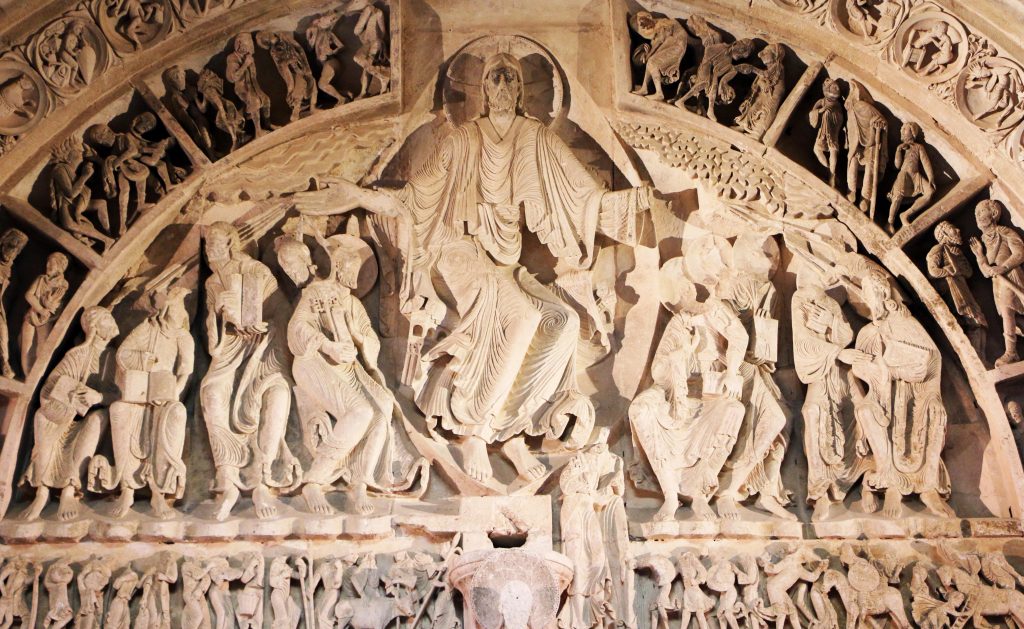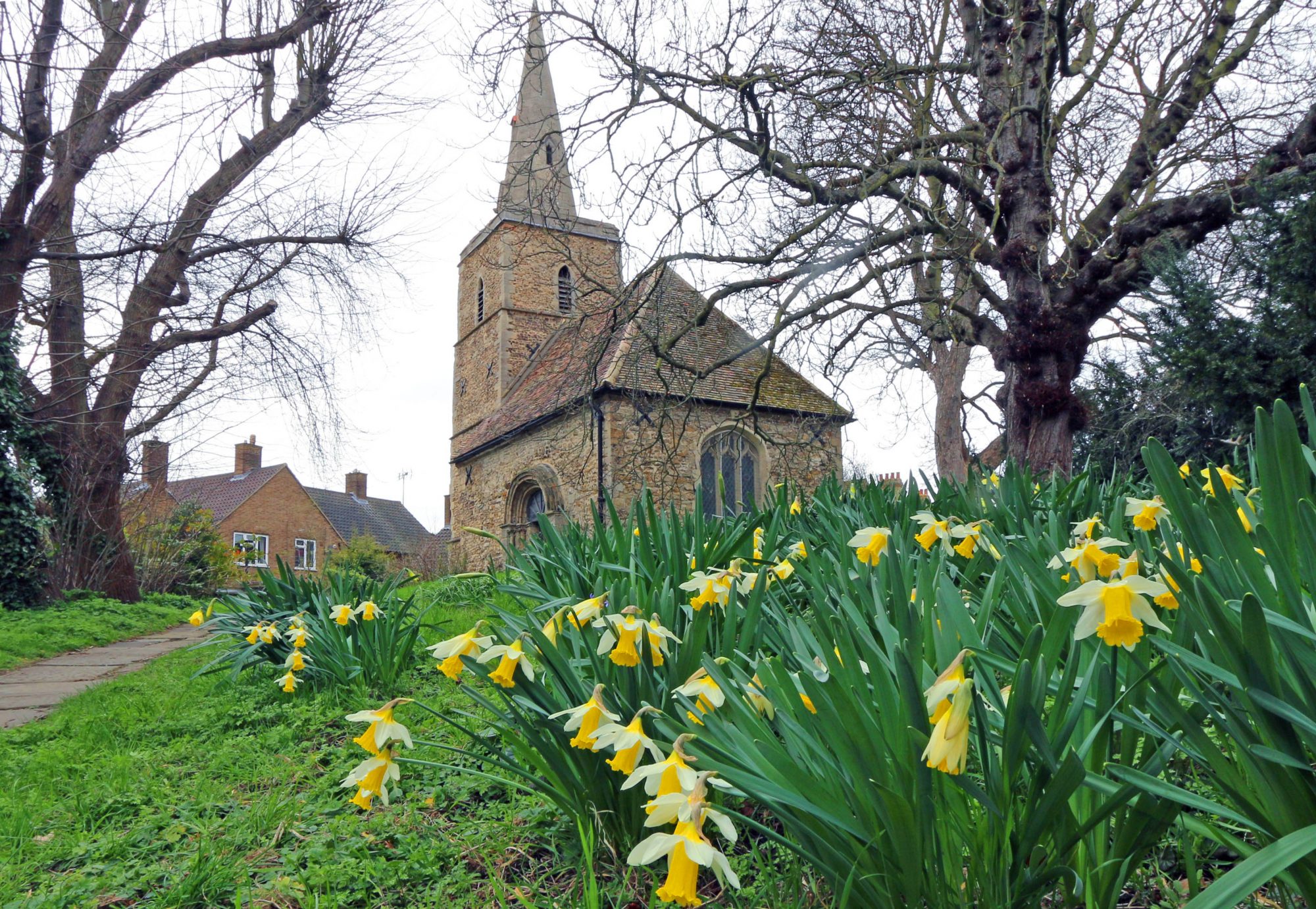 On holiday this summer Gill and I visited the magnificent church at Vezelay. Its chief treasure is a Romanesque carving over the west door which features the risen Christ with arms outstretched, dressed in swirling robes. It is unique, and surprisingly the artist responsible, Giselbertus who signed his work, had previously produced another carving, for the doorway of Autun Cathedral, and this one presented the familiar scene of the last judgement.
On holiday this summer Gill and I visited the magnificent church at Vezelay. Its chief treasure is a Romanesque carving over the west door which features the risen Christ with arms outstretched, dressed in swirling robes. It is unique, and surprisingly the artist responsible, Giselbertus who signed his work, had previously produced another carving, for the doorway of Autun Cathedral, and this one presented the familiar scene of the last judgement.
Vezelay, a place where pilgrims gathered, had been chosen as the location for preaching the crusades. The soldiers who gathered here had included Richard the Lionheart and the King of France. And the carving over the West front of Vezelay portrays the Day of Pentecost as the moment when a holy war is begun. The swirling robes of Christ show the ‘rushing mighty wind’ of the day, and people of all nations are represented. In place of a Last Judgement, with people ascending to heaven or descending to hell the two groups are Christians and non-Christians. The latter depicted as monsters, some with dogs’ heads, are no doubt intended to inspire hatred of the Muslims against whom the crusades would be directed.
In 1215, Pope Innocent called for the Fifth Crusade and in the spring of 1217 the armies from all across Europe slowly gathered and headed for Egypt. The Muslim and Christian armies camped across the Nile. As the war raged on over the next two years, thousands were killed on both sides. And, into this war zone, came St. Francis of Assisi.
Francis was the privileged son of a wealthy Italian merchant. He had been something of a tearaway, and joined a war against the neighbouring town of Perugia, where he found himself imprisoned. The experience led to his conversion. He gave up his possessions and adopted a life of peace, poverty, compassion and nonviolence. While praying on his knees before a crucifix in 1205, Jesus spoke to him from the image on the cross: “Francis! go, repair my house which is falling completely to ruin.” Francis saw this as a request to transform the entire Christian church. He was reborn as a peacemaker and was convinced that God wanted him to bring the world a message of peace.
He adopted the signature greeting “May the Lord give you peace” and constantly opposed warfare, arrogance and the violent culture of his day. While men slaughtered one another in God’s name beside the waters of the Nile, Francis gathered his community of brothers in Italy. Francis had always dreamed of preaching the Christian faith peacefully to the Muslims and yearned for an audience with a Muslim leader. Now his moment had arrived and he was going to forbid war and be a peacemaker.
In June 1219, Francis took a few brothers with him and sailed on a perilous journey across the Mediterranean to the war zone. He began to preach vigorously against the war, forbidding it and threatening disaster but was faced with foulmouthed jeers and taunts; to the Christian soldiers the barefoot little holy man was a heretic. Despite this, Francis continued his opposition to war but all of his efforts were to no avail.
Finally, Francis decided that he would act and he and brother Illuminato would venture out to meet the Muslims in their own camp. Francis understood the risks; death or imprisonment were the likely outcomes of his plan to cross the enemy lines during wartime. But Francis had a bold idea to prevent bloodbath. If the Crusade leaders would not seek peace, he would.
Sultan Malik al-Kamil, ruler of Egypt and a nephew of the great Kurd warrior Saladin, repeatedly tried to negotiate peace by returning Jerusalem to the Crusaders but the pope rejected the offer each time. Francis crossed the enemy lines and was taken to the Sultan. stood before al-Kamil. The sultan looked over the barefoot monks dressed in coarse, patched down tunics.
“May the Lord give you peace.” Francis surprised the sultan with his standard greeting. It perplexed the sultan. He noticed the similarity between Francis’ greeting and the familiar Muslim greeting of peace, “Assalam o alaikum” or “peace be upon you.”
The Quran urges to be courteous to those who use a greeting of peace: Say not to those who greet you with peace, “You are not a believer.” (The Quran: Women 4:94) and When you are greeted with a greeting, greet in return with what is better than it, or (at least) return it equally. (The Quran: Women 4:86)
Uncertain about his visitors’ intentions, the sultan asked if they had come as representatives of the pope’s army. “We are ambassadors of the Lord Jesus Christ”, Francis responded, asserting that he was God’s ambassador, not the pope’s.
This daring little man and his companion intrigued Sultan al-Kamil – they even resembled the similarly dressed Sufi men the sultan revered for their mystical insight into Islam.
Whatever Francis said, the sultan became very attentive to and listened closely. It was an amazing scene of a monk preaching the Christian faith to a Muslim monarch in the middle of a war.
The sultan’s religious advisers were rushed into his tent. Once they found out that al-Kamil was going to let Francis preach, they warned him that this would violate Islamic law.
Influenced by Sufism, al-Kamil believed he was acting within Islamic law in listening to Francis and Illuminato. The Quran does not prescribe or even refer to the death penalty for blasphemy. Indeed, the Quran suggests tolerance in the situation faced by the sultan: And you shall certainly hear much that will insult you from those who received the Scripture before you and from the polytheists. But if you persevere patiently and guard against evil, this will be the best course with which to determine your affairs. (The Quran: The House of Imran 3:186)
Al-Kamil had a prominent Sufi as his religious adviser and he saw Francis in the light of Sufism and the Muslim tradition calling for respect for Christian monks.
The Muslims’ relations with the Christians are determined for them by the Quran, which says: And you will find nearer to the friendship of the believers those men who call themselves Christians. This is because among them are learned men and monks, and because they are not arrogant. (The Quran: The Repast 5:82)
In their rough, patched up tunics Francis and Illuminato looked like Sufis, since the very name of Sufis came from the Arabic word for wool, the scratchy material used to make their robes. Like Francis, they also wore a cord rather than a belt.
Francis was a dynamic preacher. He preached from the heart and the sultan and his court listened to Francis attentively. The discussions went on for several days and had multiple participants. It was a peaceful exchange of ideas about the two competing religions. Francis and Illuminato were treated as honoured guests in the Muslim camp.
Francis was deeply impressed by the Muslim religious practices, especially the call to prayer.
The sultan offered Francis many gifts but Francis turned them down. Francis did, however, agreed to accept a token of their meeting; an ivory horn used to make the Muslim call for prayer, which is now displayed in a room of relics at the Basilica of St. Francis in Assisi. Francis used it to call people to hear him preach on his return to Italy.
Although Francis was disappointed not to have converted the sultan, he had shown Sultan al-Kamil what it meant to be a true Christian. He and al-Kamil had found a way of talking peacefully during a gruesome war. Sultan then sent Francis and Illuminato back to the Christian camp under his protection.
The encounter between Francis and the sultan provided the foundation for the World Day of Prayer for Peace in Assisi in 1986. St. Francis’s encounter with Sultan al-Kamil in 1219 can be an antidote, a reminder that responding to violence through violence cannot succeed, that goodness and respect can really change hearts.
The dynamic of stirring a populace to war has not changed over time; it still begins with demonizing the enemy, as with the poprtrayal of non-Christians as monsters at Vezelay. Francis saw through that. Gill and I had gone to Vezelay to admire the Romanesque carving over the west door. It is unique, and a signed work by the artist, Giselbertus, who had just completed a scene of the last judgement for Autun Cathedral. Vezelay is unique: the scene, to promote the crusades features the day of Pentecost. It is about making the whole world Christian. But it proposes a war, and the enemy is demonised. Our admiration of the work of art turned to revulsion against what it represented, and the distorted view of conversion seen in the unholy wars of the crusaders.
Today is St. Francis’ Day.
The road to peace is for all of us, on individual basis, at personal level. Francis took matters into his own hands by bravely seeking out a personal relationship with the sultan. And al-Kamil went deeper into his own religious tradition to retrieve the theme of respect for holy Christians, even though he was under attack by the pope’s army.
Hostility is more likely when one people is distanced from another and demonized. Peace gets a chance when the divide between people is bridged through personal relationships.
Pray especially today for Pope Francis, the first pope to choose that name, which a name untainted by warmongering predecessors. Pray that he, and we, may follow Francis in promoting peace.

From the Parish of the Ascension, Cambridge